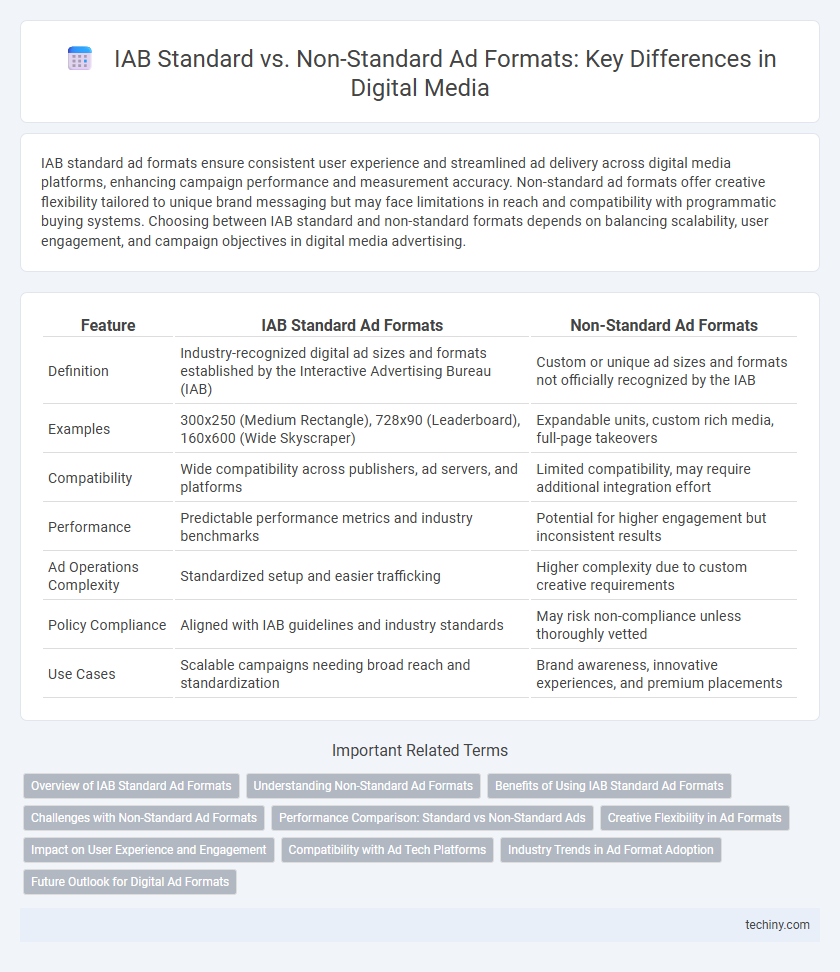IAB standard ad formats ensure consistent user experience and streamlined ad delivery across digital media platforms, enhancing campaign performance and measurement accuracy. Non-standard ad formats offer creative flexibility tailored to unique brand messaging but may face limitations in reach and compatibility with programmatic buying systems. Choosing between IAB standard and non-standard formats depends on balancing scalability, user engagement, and campaign objectives in digital media advertising.
Table of Comparison
| Feature | IAB Standard Ad Formats | Non-Standard Ad Formats |
|---|---|---|
| Definition | Industry-recognized digital ad sizes and formats established by the Interactive Advertising Bureau (IAB) | Custom or unique ad sizes and formats not officially recognized by the IAB |
| Examples | 300x250 (Medium Rectangle), 728x90 (Leaderboard), 160x600 (Wide Skyscraper) | Expandable units, custom rich media, full-page takeovers |
| Compatibility | Wide compatibility across publishers, ad servers, and platforms | Limited compatibility, may require additional integration effort |
| Performance | Predictable performance metrics and industry benchmarks | Potential for higher engagement but inconsistent results |
| Ad Operations Complexity | Standardized setup and easier trafficking | Higher complexity due to custom creative requirements |
| Policy Compliance | Aligned with IAB guidelines and industry standards | May risk non-compliance unless thoroughly vetted |
| Use Cases | Scalable campaigns needing broad reach and standardization | Brand awareness, innovative experiences, and premium placements |
Overview of IAB Standard Ad Formats
IAB Standard Ad Formats are widely recognized digital advertising specifications designed to ensure consistency, compatibility, and user experience across multiple platforms. These formats include popular sizes such as the 300x250 Medium Rectangle, 728x90 Leaderboard, and 160x600 Wide Skyscraper, which are optimized for desktop, mobile, and video environments. Leveraging IAB standards enables advertisers to maximize reach and engagement by adhering to industry-accepted dimensions and guidelines that enhance loading speed and viewability metrics.
Understanding Non-Standard Ad Formats
Non-standard ad formats in digital media refer to creative advertising units that diverge from the IAB standard sizes, offering unique dimensions and interactive features tailored to enhance user engagement and brand visibility. These formats enable advertisers to break through conventional layouts with immersive experiences such as expandable banners, rich media ads, and custom interactive designs, often resulting in higher click-through rates and improved brand recall. Understanding non-standard ad formats requires assessing their compatibility across devices, potential impact on page load times, and alignment with campaign goals to maximize effectiveness within diverse digital environments.
Benefits of Using IAB Standard Ad Formats
IAB Standard Ad Formats enhance digital media campaigns by ensuring cross-platform compatibility and streamlined ad delivery across major publishers and platforms. These formats improve viewability and user experience, leading to higher engagement rates and more accurate performance tracking. Advertisers benefit from widespread industry adoption, which reduces creative production time and lowers campaign costs while maintaining brand safety and consistency.
Challenges with Non-Standard Ad Formats
Non-standard ad formats in digital media often present challenges such as inconsistent user experience and limited compatibility across devices and platforms, leading to reduced ad effectiveness and higher bounce rates. These formats may also face increased scrutiny from ad blockers and privacy tools, causing lower viewability and engagement metrics compared to IAB standard formats. Furthermore, the lack of standardized metrics complicates performance measurement and optimization for advertisers.
Performance Comparison: Standard vs Non-Standard Ads
IAB standard ad formats deliver consistent performance metrics across diverse platforms due to their widespread acceptance and optimized design specifications. Non-standard ad formats often exhibit variable performance, as they may face compatibility issues or lack uniform measurement methodologies, impacting click-through and viewability rates. Advertisers leveraging standard formats benefit from reliable analytics and enhanced scalability, while non-standard ads can offer creative flexibility but require rigorous testing to ensure effectiveness.
Creative Flexibility in Ad Formats
IAB Standard ad formats offer consistency and broad compatibility across digital platforms, ensuring reliable delivery and measurement for advertisers. Non-standard ad formats provide greater creative flexibility, enabling unique interactive experiences that can capture audience attention more effectively. Leveraging non-standard formats requires careful optimization to balance innovation with user experience and technical performance.
Impact on User Experience and Engagement
IAB standard ad formats, designed for consistent display across platforms, enhance user experience by ensuring faster load times and seamless integration within content, which boosts engagement rates. Non-standard ad formats often offer creative flexibility and higher visual impact but can result in slower load times, intrusive placements, and increased ad fatigue, negatively affecting user satisfaction. Optimizing digital media campaigns requires balancing standardized formats for reliability with innovative non-standard ads to maximize user engagement without compromising experience.
Compatibility with Ad Tech Platforms
IAB standard ad formats ensure seamless compatibility with major ad tech platforms by adhering to industry-established guidelines for size, format, and functionality. Non-standard ad formats often face integration challenges due to inconsistent specifications, leading to limited support across demand-side platforms (DSPs) and supply-side platforms (SSPs). Publishers and advertisers prioritize IAB standards to maximize reach, reduce technical issues, and improve campaign performance in programmatic buying environments.
Industry Trends in Ad Format Adoption
IAB standard ad formats like display banners and video ads dominate digital media due to their compatibility with most ad platforms and better performance analytics. Non-standard ad formats, including custom interactive units and immersive experiences, are gaining traction as brands seek higher engagement and differentiation. Industry trends indicate a gradual shift toward hybrid strategies that combine the reliability of IAB standards with the innovation potential of non-standard formats to optimize ad effectiveness.
Future Outlook for Digital Ad Formats
IAB standard ad formats continue to dominate digital media due to widespread industry adoption and enhanced cross-platform compatibility, ensuring consistent user experience and measurable performance metrics. Non-standard ad formats, leveraging innovations like augmented reality and interactive video, drive engagement and offer unique brand storytelling opportunities, signaling a trend toward more immersive and personalized advertising. The future of digital ad formats points to a hybrid ecosystem where standardized frameworks coexist with dynamic, technology-driven formats, optimizing both scalability and audience impact.
IAB Standard vs Non-Standard Ad Formats Infographic

 techiny.com
techiny.com